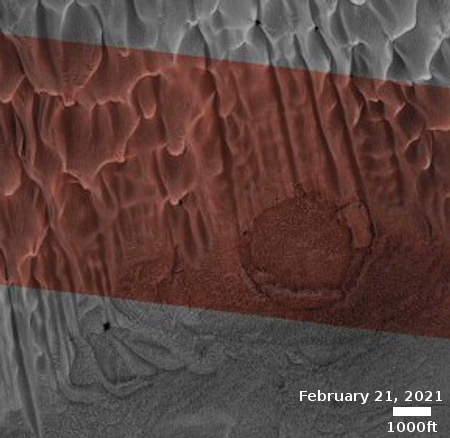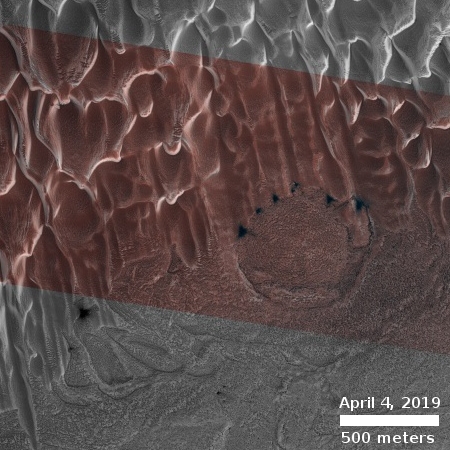Spring arrives on the northern polar cap of Mars
Cool image time! It is now spring in the northern hemisphere of Mars, and the first bits of sunlight are finally reaching its north polar ice cap. During the winter, as happens each Martian year, that polar cap of water ice gets covered by a thin mantle of dry ice no more than six feet thick. Moreover, this mantle doesn’t just cover the ice cap, it extends south as far as about 60 degrees latitude, covering the giant sea of dunes that surrounds the ice cap.
When spring comes that mantle begins sublimate away, with its base first turning to gas. When the pressure builds up enough, the gas breaks out through the frozen mantle’s weakest points, usually the crest or base of dunes or ridges, leaving behind a dark splotch caused by the material thrown up from below that contrasts with the bright translucent dry ice mantle.
Each year for the past decade scientists have been using the high resolution camera on Mars Reconnaissance Orbiter (MRO) to monitor this sublimation process. The photo above, taken on February 24, 2021 and cropped, enlarged, and brightened to post here, marks the start of this year’s monitoring program. Dubbed informally “Buzzell” by Candice Hansen of the Planetary Science Institute in Arizona, it shows dunes with a round pedestal crater just right of center. Though almost everything when this picture was taken is still covered by that dry ice mantle, in the lower left is a single splotch, the first breakout of CO2 gas that marks the beginning of the annual disappearance of this dry ice.
Last Martian year I repeatedly posted images of Buzzell to illustrate this annual process. The second image below was taken on April 4, 2019, at about the same comparable time in spring.
As you can see, that first dark splotch in this year’s image is close to but not at the same place as a similar splotch two years previously. Both were on dunes, and this change is probable because this process causes slow changes in those dunes each year, meaning that the weak spots are not necessarily going to occur at the same spot each year. As Hansen explained to me recently,
With numerous Mars years we are now looking at interannual variability and the relationship of activity level to dust storms. Also, the number and size of new alcoves is different every year so we are looking at the specifics of the meteorology and snowfall.
I would expect to see splotches on the north side of the pedestal crater this year, as shown by the image from the last Martian spring. Whether they occur in the exact same places is exactly what Hansen wishes to find out.
The wider photo below provides some interesting context. Buzzell is located a little over a mile from the 1,500 to 3,000 foot high edge of the polar ice cap, at a location where each spring avalanches occur so frequently that MRO often catches them as they happen.

That plateau at the pedestal crater is likely bedrock, making it a likely stable site for building a hotel and viewing site for watching those avalanches, just like cruise ships take tourists to watch the icebergs calving off of glaciers in the inside passage of Alaska.
On Christmas Eve 1968 three Americans became the first humans to visit another world. What they did to celebrate was unexpected and profound, and will be remembered throughout all human history. Genesis: the Story of Apollo 8, Robert Zimmerman's classic history of humanity's first journey to another world, tells that story, and it is now available as both an ebook and an audiobook, both with a foreword by Valerie Anders and a new introduction by Robert Zimmerman.
The print edition can be purchased at Amazon or from any other book seller. If you want an autographed copy the price is $60 for the hardback and $45 for the paperback, plus $8 shipping for each. Go here for purchasing details. The ebook is available everywhere for $5.99 (before discount) at amazon, or direct from my ebook publisher, ebookit. If you buy it from ebookit you don't support the big tech companies and the author gets a bigger cut much sooner.
The audiobook is also available at all these vendors, and is also free with a 30-day trial membership to Audible.
"Not simply about one mission, [Genesis] is also the history of America's quest for the moon... Zimmerman has done a masterful job of tying disparate events together into a solid account of one of America's greatest human triumphs."--San Antonio Express-News
Cool image time! It is now spring in the northern hemisphere of Mars, and the first bits of sunlight are finally reaching its north polar ice cap. During the winter, as happens each Martian year, that polar cap of water ice gets covered by a thin mantle of dry ice no more than six feet thick. Moreover, this mantle doesn’t just cover the ice cap, it extends south as far as about 60 degrees latitude, covering the giant sea of dunes that surrounds the ice cap.
When spring comes that mantle begins sublimate away, with its base first turning to gas. When the pressure builds up enough, the gas breaks out through the frozen mantle’s weakest points, usually the crest or base of dunes or ridges, leaving behind a dark splotch caused by the material thrown up from below that contrasts with the bright translucent dry ice mantle.
Each year for the past decade scientists have been using the high resolution camera on Mars Reconnaissance Orbiter (MRO) to monitor this sublimation process. The photo above, taken on February 24, 2021 and cropped, enlarged, and brightened to post here, marks the start of this year’s monitoring program. Dubbed informally “Buzzell” by Candice Hansen of the Planetary Science Institute in Arizona, it shows dunes with a round pedestal crater just right of center. Though almost everything when this picture was taken is still covered by that dry ice mantle, in the lower left is a single splotch, the first breakout of CO2 gas that marks the beginning of the annual disappearance of this dry ice.
Last Martian year I repeatedly posted images of Buzzell to illustrate this annual process. The second image below was taken on April 4, 2019, at about the same comparable time in spring.
As you can see, that first dark splotch in this year’s image is close to but not at the same place as a similar splotch two years previously. Both were on dunes, and this change is probable because this process causes slow changes in those dunes each year, meaning that the weak spots are not necessarily going to occur at the same spot each year. As Hansen explained to me recently,
With numerous Mars years we are now looking at interannual variability and the relationship of activity level to dust storms. Also, the number and size of new alcoves is different every year so we are looking at the specifics of the meteorology and snowfall.
I would expect to see splotches on the north side of the pedestal crater this year, as shown by the image from the last Martian spring. Whether they occur in the exact same places is exactly what Hansen wishes to find out.
The wider photo below provides some interesting context. Buzzell is located a little over a mile from the 1,500 to 3,000 foot high edge of the polar ice cap, at a location where each spring avalanches occur so frequently that MRO often catches them as they happen.

That plateau at the pedestal crater is likely bedrock, making it a likely stable site for building a hotel and viewing site for watching those avalanches, just like cruise ships take tourists to watch the icebergs calving off of glaciers in the inside passage of Alaska.
On Christmas Eve 1968 three Americans became the first humans to visit another world. What they did to celebrate was unexpected and profound, and will be remembered throughout all human history. Genesis: the Story of Apollo 8, Robert Zimmerman's classic history of humanity's first journey to another world, tells that story, and it is now available as both an ebook and an audiobook, both with a foreword by Valerie Anders and a new introduction by Robert Zimmerman.
The print edition can be purchased at Amazon or from any other book seller. If you want an autographed copy the price is $60 for the hardback and $45 for the paperback, plus $8 shipping for each. Go here for purchasing details. The ebook is available everywhere for $5.99 (before discount) at amazon, or direct from my ebook publisher, ebookit. If you buy it from ebookit you don't support the big tech companies and the author gets a bigger cut much sooner.
The audiobook is also available at all these vendors, and is also free with a 30-day trial membership to Audible.
"Not simply about one mission, [Genesis] is also the history of America's quest for the moon... Zimmerman has done a masterful job of tying disparate events together into a solid account of one of America's greatest human triumphs."--San Antonio Express-News



